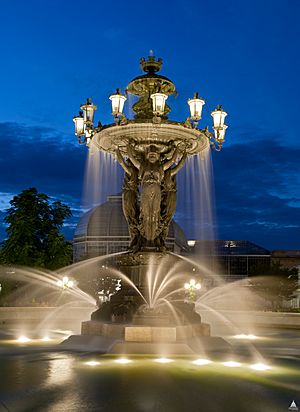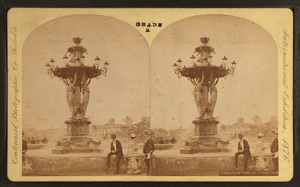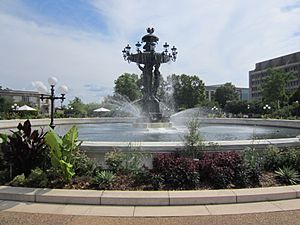Bartholdi Fountain facts for kids
Quick facts for kids Bartholdi Fountain |
|
|---|---|
| The Bartholdi Fountain in Washington D.C. (1876) | |

The restored Bartholdi Fountain illuminated, summer of 2011, from the Architect of the Capitol
|
|
| Artist | Frédéric Auguste Bartholdi |
| Year | 1876 |
| Type | Bronze |
| Dimensions | 910 cm (30 ft) |
| Location | Washington, D.C. |
| 38°53′14″N 77°00′46″W / 38.887127°N 77.012669°W | |
| Owner | United States Botanic Garden |
The Bartholdi Fountain is a huge public fountain designed by Frédéric Auguste Bartholdi. He is the same artist who later created the famous Statue of Liberty! This amazing fountain was first shown at the 1876 Centennial Exposition in Philadelphia, Pennsylvania. Today, you can find it in Washington D.C., at the United States Botanic Garden, near the United States Capitol.
The Story of the Bartholdi Fountain
The Fountain of Light and Water, which people usually call the Bartholdi Fountain, was made for the 1876 Philadelphia Exposition. This event celebrated the 100th birthday of the United States. French sculptor Frédéric Auguste Bartholdi designed it. It was built by the Durenne foundry in France. This company was famous for its cast-iron fountains.
Bartholdi offered the fountain to the Exposition for free. He planned to sell it after the event. He also hoped to sell similar fountains to other cities. The fountain stood in the middle of the main area, close to the Exposition's entrance.
When the Exposition ended in 1877, Bartholdi could not find anyone to buy his fountain. One year later, the United States Congress bought it. They paid him only six thousand dollars, which was half of what he first asked for.
In 1878, the fountain was placed at the bottom of Capitol Hill in Washington, D.C. It stayed there for many years. In 1926, it was moved and stored away. This was done to make space for the George Gordon Meade Memorial and other improvements. In 1932, the fountain was moved to its current spot. It is now in the United States Botanic Garden, on the grounds of the United States Capitol.
In 2008, the Architect of the Capitol started a full restoration of the fountain. This was the first complete repair since 1927. The restoration fixed damage to the metal parts. It also added new pumps and a modern water cleaning system. A special zinc coating was put on to protect the original cast-iron. The fountain was returned to Bartholdi Park in the spring of 2011.
What Does the Fountain Look Like?
The fountain is made of several layers of basins. These are held up by sculptures of classic figures. The cast iron is covered with bronze. It stands 30 feet (9.1 m) high and weighs 30,000 pounds (14,000 kg). It sits in the middle of a large, round marble pool.
Three figures of women stand on a triangle-shaped base. This base has designs of seashells and three reptiles that spout water. These figures support the lower cast iron basin, which is called a "vasque." This vasque has a circle of twelve lamps around it.
In the center, three kneeling tritons hold up another, smaller vasque higher up. Water shoots from a crown at the very top. It then flows down into the smaller vasque. From there, it cascades into the larger vasque. Finally, it spills into the main pool below. The flowing water was lit up by gas lamps. Later, these were changed to electric lights. This made it one of the first monuments in Washington, D.C., to be lit at night. Because of this, it was a popular place to visit in the evenings during the 1880s.
See also
 In Spanish: Fuente Bartholdi para niños
In Spanish: Fuente Bartholdi para niños



